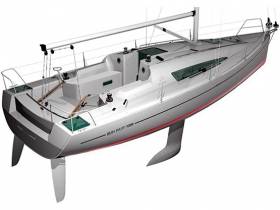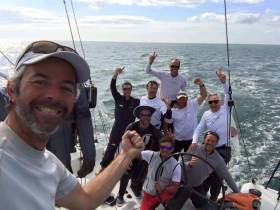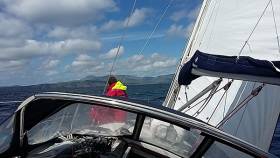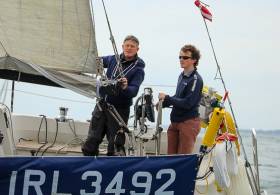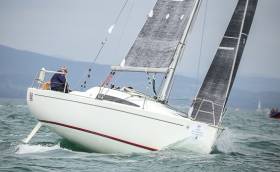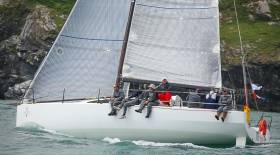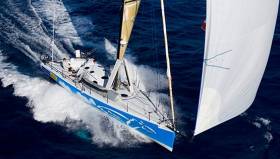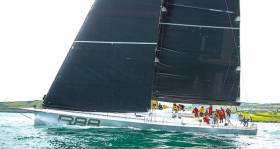Displaying items by tag: Round Ireland
Up–Down Round Ireland Race Sees Battle Of The Bulge
Day 4 1800 An intriguing Round Ireland Race tussle has been taking place this afternoon and evening along Ireland’s most easterly coastline where County Down bulges out towards both Galloway in Scotland and the Isle of Man in the middle of the Irish Sea writes W M Nixon.
Four boats – three Irish, one French – have been trying to trade places in the southwest to south winds as they dodged the north-going ebb tide across the mouth of Belfast Lough, and then rock-hop on down the outer coastline of the Ards Peninsula and beyond to where – well south of the entrance to Strangford Lough – the bulge comes to a sudden stop at St John’s Point with its very conspicuous lighthouse.
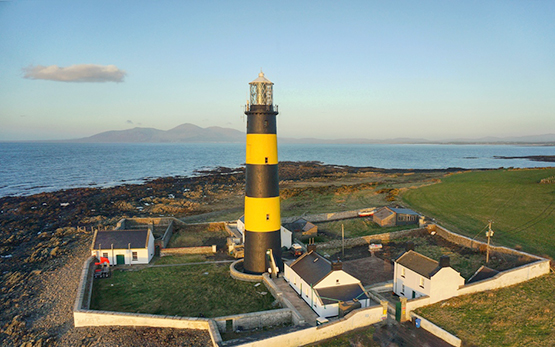
Sentinel of the East Coast – St John’s Point in County Down with the Mountains of Mourne beyond
There are of course many more than just four boats in the area as the Volvo Round Ireland Race 2016 continues on its way. And far to the north, there are other boats which have been hung up in the strongest tides in the Rathlin Island area, and they probably deserve a report to themselves. But really, all they’ll want to do is get on with it again as the tide finally turns again in their favour around 1900hrs.
At this stage of the race, however, followers of the fleet have identified these four particularly interesting crews and boats of broadly comparable size still racing. And in these final stages of the biggest Round Ireland Race ever, it’s fascinating for race addicts to see how they play their hands as the game draws to a close.
The four boats, with their IRC ratings in brackets, are Paul O’Higgins new JPK 10.80 Rockabill VI (1.046), Dave Cullen’s J/109 Euro Car Parks (1.016), Patrice Carpentier’s Sunfast 3200 GROUPE 5 (0.995), and Stephen Quinn’s J/97 Lambay Rules (0.971).
In terms of distance from the finish they’re widely spread, as Rockabill is 58 miles from Wicklow, Euro Car Parks is 67, Groupe 5 is at 80 miles, and the smallest one, Lambay Rules, is 102. Thus it must hardly seem a race at all to anyone accustomed to the One-Design scene. But believe me, there’s a ding-dong going on out there, and from now to the finish at Wicklow some time tomorrow, it’s neck-and-neck on the figures, even if they’re barely in sight of each other.
Currently in the overall placings, allowing for the fact that both Rambler 88 (George David) and Teasing Machine (Eric de Turckheim) are well finished in first and second and secure in their placings, this Battle of the Bulge has GROUPE 5 in third overall, Euro Car parks is fourth, Lambay Rules is sixth, and Rockabill VI is seventh.
Out in a race of her own well to the south is the fourth-placed boat, Michael Boyd’s much larger First 44.7 Lisa. But although Lisa has been milling her way at a fine pace towards the finish line all through the afternoon, at a position 7 miles east of the Baily on Dublin Bay she is about to run out of favourable tide with 22 miles still to sail to the finish. And though the M2 weather-buoy ten miles to the eastward is still showing 12 knots of good southerly breeze, inevitably Lisa’s crew are going to have a difficult evening of it with a foul tide and winds all over the place off Wicklow itself.

By contrast, the smallest boat in our select group, Stephen Quinn’s Lambay Rules (pictured above), is off the southeast corner of Belfast Lough, and the new flood tide which is going to hinder Lisa in St George’s Channel will be a favourable tide for Lambay Rules. It will give her a mighty push through the remainder of the North Channel and out into the Irish Sea, where her three closest rivals are already working on tactical decisions which will stay with them for the remainder of the race.
Leader of the pack Rockabill VI is close-hauled on port well off Carlingford Lough, hanging in very well with Chris and Patanne Power Smith’s J/122 Aurelia, which is tough on Aurelia but good news for Rockabill. Next in line is Euro Car Parks, which hugged the coast more on the leg from South Rock Light to St John’s Point, but is now striking out in open water in some style, though on the 1800hrs fix, Rockabill is shown as slightly faster.
Early in the afternoon. Patrice Carpentier on the two-handed GROUPE 5 became disenchanted with staying with the rest of the fleet as they held close along the shore from the South Rock to St John’s. So he took what now looks like a flyer on starboard, but it may have been a good one, as he’s back on port and making a useful 6.2 knots.
GROUPE 5’s low rating puts her very much in the frame, as too does the even lower rating of Lambay Rules which is currently off Ballywalter showing only 4.9 knots over the ground, as the tide has still to turn. It’s very much Game On for a long night. We’ll take up the story again with our next report in the morning.
See Round Ireland tracker here and keep to up to date with the fleet's progress with Afloat's regular Round Ireland 2016 updates here
Day 5 1000: With Eric de Turckheim’s beautifully-sailed A13 Teasing Machine finally finished in Wicklow at 0859 this morning to retain her second overall in IRC in the Volvo Round Ireland Race 2016 writes W M Nixon, the current outstanding feature of the race is the huge gap between the group of boats currently approaching Wicklow, and the bulk of the rest of the fleet well back to the north, sailing off the County Down and County Antrim coats.
Like it or not, tides are what it’s all about that this stage. First time Round Ireland racers sometimes find it difficult to get their heads round the fact that at the south end of the great pond which is the Irish Sea, the ebb tide runs south through St George’s Channel. But at the north end, it runs north out through the North Channel.
For anyone simply looking at an Irish Sea chart, it’s bleedingly obvious that this is the only way it can happen. But of you’ve done your early sailing years on the shores of either channel, the directions of the local flood or ebb will inscribed in your childhood mind. Yet with the narrow sea-level outlook and weather-obsessed mindset which participation in the Volvo Round Ireland Race induces, there are times when tired sailors, and sometimes even their awfully sagacious navigators too, find themselves having to make a conscious effort of memory to clarify the way the flow will be going.
However, after the fourth night of racing - much of which has seen the bulk of the fleet sailing their little hearts out between Rathlin Island on Ireland’s northeast corner and the finish line at Wicklow Harbour 150 miles away to the south - we can be reasonably sure that an awful lot of people now have the directions of relevant tidal streams centrally inscribed in their thinking. Because since about 0130hrs, the was roaring north for six hours against the fleet in the North Channel. But away to the south, those boats which had managed to get themselves to the latitude of Skerries found themselves on an increasingly positive magic carpet of south-going ebb tide which helped to overcome the adverse effects of light headwinds, and carried them down to finish at Wicklow in time for breakfast.
The result is a huge gap in the fleet still racing. Indeed. there’s only one boat to be found in the 65 miles between County Wicklow and Dundrum Bay, and that’s Joy Fitzgerald’s Class 40 Concise 2 (pictured below) about twenty miles due east of Lambay, second in Open 40 and making good better than 7 knots to windward even if the new flood tide is increasingly slowing progress towards the finish 32 miles away.

There is then a clear gap of 40 miles and more back to the next boat, Michael Boyd’s First 44.7 Lisa (pictured below). But despite the night’s foul tide which moved crewman Paddy Boyd to send us an 0400 text outlining the challenge they faced, Lisa has long since managed to break clear of the narrow bits of the North Channel, and her target now will be to get to the latitude of Skerries in time for the new south-going ebb around 1400hrs.

Meanwhile she continues to lie second in IRC 1 and fourth overall, but seventy miles away at Wickow, Teasing Machine’s race is finally finished, and a great race it has been too. Since midnight her crew had been playing a cat-and-mouse game down the Dublin and Wicklow coasts with Ross Hobson’s much-larger Open 50 Pegasus. While there’d never been any doubt that Teasing Machine would beat the much higher-rated Pegasus on handicap, the sport was such that beating her boat-for-boat became the target, and Teasing Machine confirmed herself in the on-the-water lead in the final three miles to Wicklow, crossing the line ahead of Pegasus at 0859hrs.
Admittedly it was akin to bear-baiting, as the big Pegasus is in the two-handed division, and aboard her Ross Hobson and Chris Briggs were boggle-eyed with exhaustion. But the crew of Teasing Machine had given their all as well, and if we – just for a moment – discount the celestial performance of George David’s Rambler 88 to claim what is now a fabulous new quartet which includes mono-hull line honours, course mono-hull record, open mono-hull round Ireland record, and overall win on IRC, then we see that Teasing Machine has also done something very exceptional, as the distance gap between her and next in line is big in miles if not in corrected time, so with lighter winds the likelihood is it will get bigger.

That said, maybe we shouldn’t count the Machine’s chickens just yet, as currently the second overall is Patrice Carpentier’s Jeanneau Sunfast 3200 GROUPE 5 (pictured above), which also leads the two-handed division, Clearly this is another exceptional performance in a race featuring many exceptional performances.
It has been a night of extremely challenging conditions in the dark heart of the North Channel, yet out of it GROUPE 5 had done extremely well, and she is currently off the north side of Belfast Lough, making eight knots with 115 miles to the finish with the new south-going flood tide under her. But rather painfully for Irish supporters, two miles astern and sailing at a slightly better 8.2 knots is Dave Cullen’s J/109 Euro Car Parks (pictured below).

The fact that Groupe 5 got through the Cullen boat during the night shows just how crazy a place the Antrim coast can be for racing in headwinds and against the tide. But otherwise things are good for Euro Car Parks, as she has got back to first place in IRC 3. Former IRC 3 leader Rockabill VI (Paul O’Higgins) is currently 8 miles ahead of Euro Car Parks, and getting past Mew Island as we write, but her higher rating has her lying second in IRC 3.
Overall in IRC, the placings confirm Rambler 88’s win, and it’s unlikely that Teasing Machine will be disturbed from her second place, though GROUPE 5 should not be discounted for some time yet, and her potential to upset the rankings will be of interest to the betting fraternity. But as of 0945 the rankings were 1st Rambler 88 (finished), 2nd Teasing Machine (fnished). 3rd GROUPE 5, 4th Cavatina (Ian Hickey), 5th Euro Car Parks, 6th Lisa, 7th Lambay Rule (Stephen Hyde), 8th Tockabill VI (Paul O’Higgins), 9th Bam (Conor Fogerty), 10th Sarabande (Rob Mabley).

The #Cavatina2016 team: Ian, Len, Sean, John, Miah & Billy! #RoundIreland16 #LookAtTheCamera #ShoreCrew pic.twitter.com/VV8lcPrjFv
— Cavatina Irl3861 (@cavatinaireland) June 18, 2016
The arrival of the extremely low-rated veteran Cavatina (pictured above) in the top ten rankings will come as no surprise to seasoned round Ireland observers – it’s the fact of simply being right here at the end of the race which has seen Cavatina record Round Ireland overall wins in times past, and while it’s impossible for her to do it this time round, she is in line for quite a respectable showing nevertheless.
See Round Ireland tracker here and keep to up to date with the fleet's progress with Afloat's regular Round Ireland 2016 updates here
Round Ireland Sailing But at a Leisurely Pace!
As Afloat.ie reported in April, Sailing In Dublin Club yacht Silverwind set out on the first of its fourteen week long cruises around Ireland this summer. Club member Damien Byrne describes his week long cruise with stunning views of West Cork.
After two weekend delivery trips, the first from Dun Laoghaire to Kilmore Quay and the second weekend onto Kinsale, Sailing In Dublin Club’s yacht Silverwind set out on the first of its fourteen week long cruises around Ireland. Each of the fourteen weeks, will see the Clubs cruising yacht manned by different members each week, move around the coast of Ireland. On Saturday the 11th June the first crew of five met onboard the Sun Odessey 35, skippered by club Captain Linda fFrench. Of the five crew Linda, Damien and Ann are based in Dublin with Peter based in Co Clare and Anthony in West Cork. The crew was a mix of seasoned and novice sailors.
Having provisioned on the first day the crew set off for Glandore. On route the Captain, went through the safety procedure and equipment on board and also practiced man overboard procedures. The relatively short trip allowed the crew to become familiar with the boat and allowed some time to find their sea legs. The first night involved anchoring in Glandore on a wet evening and the crew cooked on board.
The following morning was a nice bright morning and allowed Anthony to view his home town from a different angle than normal as the boat left for Baltimore. With the winds from the Northwest the crew faced a beat to Baltimore Harbour. On arrival in Baltimore Bay the crew tied up at the more sheltered Sherkin pontoon at the Islanders Rest Hotel. The Hotel provides great food especially the fish dishes which were enjoyed by all. The forecast for Monday included a small craft warning and the crew decided to stay tied up for the day. This time allowed a full walking tour of Sherkin Island which ended in time to watch the first of Ireland’s games in the Euro championship. As there was other boat crews also tied up there was a big crowd watching the match though many did not appear to be too familiar with the game of soccer!

On Tuesday the crew intended to head for Lawrence Cove on Bere Island via the Fastnet, and after a healthy breakfast, and sandwiches made for the long day ahead, they headed out to sea. The sun shone, basking shark and dolphins were spotted, and the crew got great pictures of The Fastnet (above). However it was turning into a long day of sailing, and with a strong and unfavourable wind and lumpy seas, a mixture of sailing and motor sailing, the crew opted for plan B and headed into the sheltered harbour of Crookhaven and picked up a visitor mooring. It was a glorious sunny afternoon so a picnic of a selection West Cork cheeses was enjoyed on deck. Later the crew blew up the dinghy and headed ashore for dinner. After a drink in the local un-crowded hostelry they headed for the local restaurant which appeared almost empty only to be told they were fully booked out with a bus load of tourists which were about to arrive! The only option was to head back out to the boat for a West Cork culinary breakfast of Clonakinty puddings and sausages which we had intended for the morning.
Overnight the wind dropped and the morning was beautiful and sunny as the crew once again headed for Lawrence Cove marina in Bere Island (below). With a favourable wind they sailed past the Mizen and then as they turned north, resorted to the engine to get to Bere Island before the winds increased later in the day. Being under engine allowed the boat to hug the coast and get close up views and pictures of Mizen Head, Three Castle Head and Sheep Head. On arrival in Lawerence Cove we were met by the friendly marina owner Rachel who provided us with plenty of local information and booked a reservation for us in the Lookout restaurant. Although this restaurant is located at the other end of Bere Island the restaurant operates a free shuttle service to and from the restaurant. All the crew enjoyed a fabulous feed of scallops and fresh fish. The family that own the restaurant were also involved in the salvage of the tallship Astrid (which sank off the Cork coast in 2013) and pictures of the salvage operation are on view in the Restaurant. The crew also walked around the old Navy base which was occupied by the British until 1938. Some of the Navy buildings were used by Glenans sailing school until 1993.
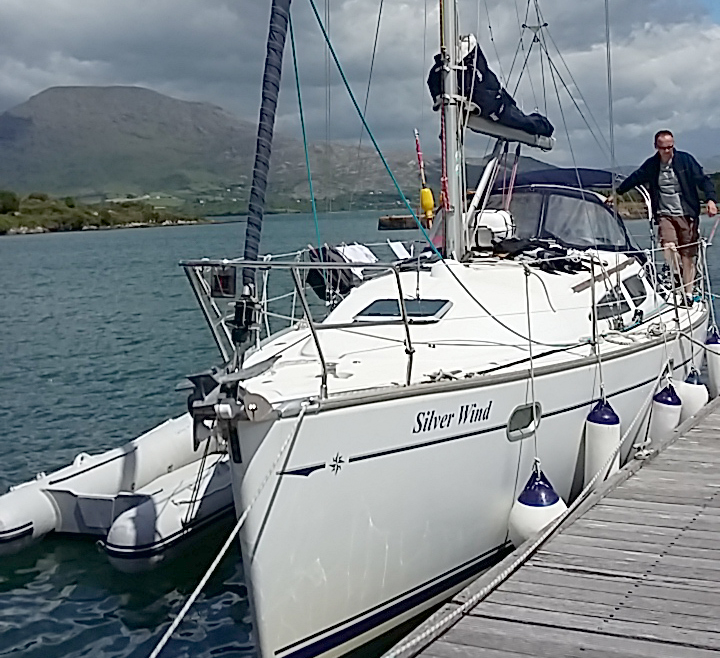
The crew set off the following day for Derrynane. The wind was again strong from a Northerly direction and the crew were very happy to tie up to a visitors mooring in the very sheltered and beautiful harbour. Friday was the last day of sailing and with beautiful sunshine and winds moderating, it turned out to be one of the most enjoyable days sailing. The crew got good views of the coast and of the Skelligs, pods of dolphins swam along with the boat a few times and Fungi the Dingle dolphin also made an appearance when entering Dingle Harbour. After a night out in Dingle with lots of traditional music and craic, all that was left to do was to clean the boat for the next Crew who will bring the boat further on its journey around Ireland.
All in all it was a fabulous week cruise with stunning views of the West Cork and Kerry coastline and Islands, with visits to the more remote parts of Ireland and close encounters with dolphins and basking sharks. Sailing In Dublin Club provides a fleet of boats and the company to sail and cruise in Ireland at very low costs. For more information visit www.sailingindublin.ie
Round Ireland Race Parking Lot At Inishtrahull
Day 4 2100: The lonely island of Inishtrahull beyond Malin Head marks the most northerly point of the Volvo Round Ireland Race writes W M Nixon. Or rather, some unmarked rocks strung out beyond Inishtrahull are the ultimate marks of the course. It’s a messy tide-riven sort of place where you wouldn’t want to linger unless visiting Inishtrahull itself. So it’s always a source of satisfaction to put the rocks of Inihstrahull astern as fast as possible when racing towards that distant finish line in Wicklow.
Yet despite its exposed nature, it’s surprising how often Inishtrahull has served up an unexpected little area of calm during the biennial circuit of Ireland. Or maybe because it’s so unexpected that the times it has occurred loomed unnaturally large in the memory. But Inishtrahull did very definitely serve up a little bit of local calm, and then some, this evening.
To the westward, boats were sailing merrily along towards Inishtrahull, well pleased with having put Tory Island and the west coast astern. And to the eastward, other boats were likewise sailing briskly, in their case towards Rathlin Island and the many imponderables of the North Channel beyond it. But at Inishtrahull, there were two or three boats going nowhere.
And one of those registering just about zero knots was Paul O’Higgins’ JPK 1080 Rockabill, at the time carrying Ireland’s best hopes for an overall podium place. Having been moving along very satisfactorily with a 40 mile gap ahead of the next boat in Class 3, Dave Cullen’s J/109 Euro Car Parks, suddenly Rockabill’s fine lead was evaporating fast. Lines of communication buzzed, and it was assumed she’d got hooked up on the lobster pot line. Indeed, there were reflections on just how hooked up a twin-rudder boat could get in twisting and turning to get free. But as it became clear that other boats were running into the Great Glass Wall of Inishtrahull and coming to a stop, it became a matter of waiting on tenterhooks until Ireland’s best hope got moving again.
It was more than a little calm, for when those Rockabill numbers started to go up again, Euro Car Parks had knocked almost twenty miles off the Rockabill lead. But despite the JPK rating 1.046 to the 1.016 of the J/109, Rockabill continues to lead Class 3, but her place on the podium has slipped for now, she’s back in fifth overall.

However, it’s still Ireland at third overall, as RORC Commodore Michael Boyd’s First 44.7 Lisa (above) has sailed into the breach, while fourth place is now held by Patrice Carpentier’s Sunfast 3200 Groupe 5, though only by a small margin ahead of Rockabill.
So there’s all to play for as they close in to the North Channel with the tide sluicing in their favour until the small hours. And out at the other southeast end of that same perverse bit of water, Eric de Turckheim’s A13 Teasing Machine is continuing to give a Master’s course in tactics as she deal with the challenge of beating all the 90 miles from the South Rock Light to Wicklow with a wind which is forecast to veer a little, but then back again.
In anticipation of the veer, de Turckheim’s crew have been slugging along to the southwest, and are currently about three miles off the little port of Annalong in the Mourne Mountains, making 7.4 knots on a heading of 224.05. Or at least that’s how it was with the 2030 fix. We might expect a tack before the 2100 position check. But you never know, maybe there is a reason why she’s called Teasing Machine after all.
Regardless of when she tacks, tomorrow will have dawned and be well on its way by the time Teasing Machine gets to Wicklow. So Rambler 88’s overall win is increasingly secure.
See Round Ireland tracker here and keep to up to date with the fleet's progress with Afloat's regular Round Ireland 2016 updates here
Foynes Yacht Big Deal is 14th Round Ireland Race Retiral
Day 4 2000: The latest retiral from the 64–boat Volvo Round Ireland Race fleet is the two handed Foynes Yacht Club entry Big Deal. The Father and son team of Derek and Conor Dillon retired in to port of Fenit in County Kerry this morning after issues with sails on their Dehler 34 sponsored by Union Chandlery. The sole Foynes entry was the Class 4 leader last Saturday night. The 14 retirals confirmed to date are as follows:
- Sun 12.30 Trilogic retired and returning to Dunlaoghaire – Gear sail problems
- Sun 15.33 Xanadu retired to Kinsale – reason not specified
- Sun 16,26 Medicare First Aid retired to Ballycotton – reason not specified
- Sun 17.08 Andante retired to Dunmore East – reason not specified
- Sun 17.07 Port of Galway retired to Crosshaven – Crew ill but nothing serious.
- Sun 18.01 Applegreen Sail for Kids retired to Crosshaven – Gear problems
- Sun 18.10 Denebola retired to Waterford – Autohelm damage
- Sun 18.14 Desperado of Cowes retiring to Kinsale – Sail damage
- Sun 18.40 Concise8 retiring to Crosshaven – reason not stated
- Sun 20.27 May Contain Nuts retiring to Crosshaven – reason not stated
- Sun 20.46 Fulmar Fever retiring to Dunmore East – reason not stated.
- Mon 04:40 Tanit retiring to Cork - nothing serious
- Mon 08:20 Quid Non retiring gear failure inner forestay- gone to Kinsale
- Tue 07:40 Big Deal retiring to Fenit - Sails issues
See Round Ireland tracker here and keep to up to date with the fleet's progress with Afloat's regular Round Ireland 2016 updates here
Irish Boats Dominate Class 3 In Round Ireland Race 2016
Irish sailing was well represented in the sprint of the MOD 70s to new records yesterday in the Volvo Round Ireland Race 2016, with Damian Foxall on board the first-to-finish Musandam-Oman, while Justin Slattery was only minutes away aboard Phaedo 3 writes W M Nixon. Yet oddly enough, as they have made their careers on the international stage, both of them were Round Ireland newbies. There’s nothing like starting at the top…
Admittedly the green jersey was absent from the new mono-hull record setter, the American Rambler 88, but we can take great encouragement from the showing by our boats in most of the IRC Divisions, with Class 3 in particular currently seeing a clean sweep as they race along the north coast.
Leading the class in some style – and lying third overall behind Rambler 88 and Eric de Turckheim’s Teasing Machine – is Paul O’Higgins’ very new JPK 10.80 Rockabill VI (RIYC), which was passing Inishtrahull at today’s 1630hrs position fix. This remarkable twin-rudder French design is proving to be such a consistently good performer in major events that she poses a problem for potential owners. Put bluntly, if you get a JPK 10.80 and don’t win races, then where are you going wrong?
Be that as it may, with a crew of all the talents built around Mark Pettit and Brian Mathews, Rockabill VI is going almost embarrassingly well, as any other boats around her are significantly larger, and the second-placed boat in Class 3 – Dave Cullen’s J/109 Euro Car Parks – is well astern off the east end of Tory Island. Nevertheless the Cullen boat has a massive lead on all the other J/109s, so her distant second in class is not so much a reflection on her own performance, rather it’s a reinforcement of the impression that the JPK 10.80 is in a league of her own.

Third in IRC 3 is Conor Fogerty’s Sunfast 3600 Bam!, (pictured above) which has certainly had her ups and downs in this tough race, but as we write she is sweeping past Bloody Foreland at a crisp 8 knots, shaping up to gybe for the west end of Tory Island.
In the overall rankings for Irish contenders, RORC Commodore Michael Boyd (RIYC) is next best after Rockabill VI, as his First 44.7 Lisa is fourth overall and second in Class 1 behind Teasing Machine, while Euro Car Parks is sixth OA, and Alan Hannon’s Reichel Pugh 45 Katsu is 7th.
Next up on the overall leaderboard for Ireland is Stephen Quinn’s little J/97 Lambay Rules at 10th, and she also lies second in Class 4 behind Patrice Carpentier’s Sunfast 3200 Groupe 5 from France. Carpentier is putting in a fantastic showing, as he is in the Two-Handed Division, which he now leads from Michel Kleinjan’s Open 40 Roaring Forty 2, with Ireland’s top representatives being Liam Coyne and Brian Flahive in the First 36.7 Lula Belle at fifth (pictured below).

All of these boats are still sailing in the lee of the land in southerly breezes along the north coast, although as anyone who has done the Round Ireland will readily affirm, being in the lee of the land does not necessarily prevent the North Coast from being one very restless bit of water.
But the larger leaders of the main pack of boats are now bashing their way into the Irish Sea, after battling with a foul ebb tide in the North Channel for the last five hours. Admittedly when the new flood starts to make at around 1900hrs, it will kick up a steep sea if the southerly wind stays at its current fresh level, but meanwhile during the north-going ebb, it has been a joy to watch the tactics of Eric de Turckheim’s Teasing Machine as she rock-hopped her way close inshore down the County Down coast to minimize the effects of the adverse stream.
On Saturday evening in the early stages of the race, she did exactly the same thing successfully along the Wexford coast from Cahore Point southwards. So having observed this latest bit of neat tide dodging, we can only assume that the French navigator aboard the de Turckheim boat once upon a time cruised the Irish coast in a very small boat, and learned that getting in out of the worst of the tide can make a great difference to progress.
Whatever way these skills were learned, Teasing Machine had just passed the South Rock Light at the 1700hrs position fix, and she now has less than 90 miles to go to the finish, whioe her neresty challenger, the Open 50 Pegasus, is over towards the isle of Man and a mile or two further from the finish.
But unlike Rambler 88 which was able to lay the course, today’s backing of the wind makes it almost inevitable that Teasing Machine and Pegasus are going to have to beat every inch of the way to Wicklow. As we wait for that arrival, there seems to be one inescapable message which boat owners can draw from the Volvo Round Ireland Race 2016. If you want to do well in the big time offshore races these days, get a second rudder.
IRC overall leader Rambler 88 is twin rudder configuration. So too is Teasing Machine in second overall. And it’s just the same with Rockabill VI in third.
There it is, folks. Old-fashioned single centre-line rudders are just sooooo yesterday…
See Round Ireland tracker here and keep to up to date with the fleet's progress with Afloat's regular Round Ireland 2016 updates here
High Noon & High Water In The North Channel As Battle Of The Tides Takes Over Round Ireland Race 2016
Day four noon: They talk of tidal gates at various stages of the Volvo Round Ireland Race, but in those narrow seas between Ireland and Scotland which are the North Channel, for smaller craft the tides can be a complete four hour barrier during the peak periods of the adverse stream.
High Water Belfast today is 1233 hrs, and with the “Strawberry Moon” of the Summer Solstice, it’s quite a big tide which will start ebbing northward with increasing vigour through lunchtime.
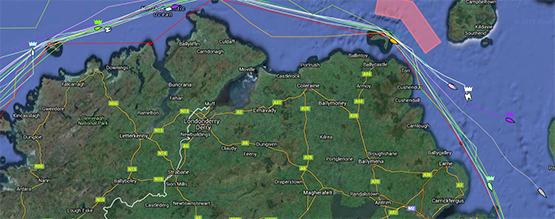
The battle for first on the water among the “real” fleet went on between Teasing Machine and the two-handed Open 50 Pegasus of Northumberland right through the night and morning, with the larger Pegasus finally getting ahead as they came past Inishtrahull. As of now off Belfast Lough in a south to southwest breeze, the pair of them have to face the imminent bigger challenge of uphill sailing against the tide for the next 20 miles to the South Rock Light off the County Down Coast, where they start to get into the open and less tidal waters of the Irish Sea.
The 12 noon positions from Yellowbrick show that after a stab southwestward which hinted at eventual tide-dodging in Belfast Lough, Teasing Machine is back on starboard and making 6.7 knots, while Ross Hobson and Chris Briggs on Pegasus are taking it on the chin by slugging along southeastwadrs on port tack at mid-Channel. They’re now a dozen miles seaward of Portpatrick on the Scottish coast and making 8.7knots, and though they’re only a mile nearer the finish at Wicklow, that’s a mile which could be crucial as the adverse tidal heave gains full power.

A dozen miles astern of the two leaders, Michel Kleinjans Open 40 Roaring Forty 2 (pictured above) has taken the option of inclining to the east towards the broad mouth of the lower Firth of Clyde, and her current speed of 8.1 knots is encouraging, while back towards the northeast turn at Rathlin Island, Alan Hannon’s Reichel-Pugh 45 Katsu has taken full advantage of the fierce flood tide past Tor Head while it was still in full flow, and as of noon she was still in almost full benefit of it with 9.6 knots over the ground, keeping her third in IRC 1 and 5th in IRC Overall.
On down the line, Paul O’Higgins’ JPK 10.80 Rockabill IV was four miles past Tory Island at noon, and she may make gains on those ahead, as she won’t start to feel the adverse tide until she gets to Inishtrahull, when she’ll already be anticipating new new favourable flood. She continues first in IRC 3, is third in IRC Overall, and is now a remarkable 42 miles ahead of Euro Car Parks which continues second in IRC 3.
See Round Ireland tracker here and keep to up to date with the fleet's progress with Afloat's regular Round Ireland 2016 updates here
Long Run On A Long Coastline – Volvo Round Ireland Race Continues Along The West Coast
Day3 2030 Today has seen surfeit of drama at Wicklow writes W M Nixon, and all of it with a happy ending. The new day dawned to find the three MOD 70s had finished the Volvo Round Ireland Race 2016 in record time within minutes of each other. And then in mid-afternoon there came the almost clinical arrival of Rambler 88, with another new record and a chance of the monohull treble.
In the circumstances, the casual observer could be forgiven for thinking the steam has gone out of the Volvo Round Ireland Race 2016. But a casual observer has never experienced the true enthusiasm which racing round Ireland in any boat large or small, famous or unknown, can engender in its addicts.
For sure, the many boats now racing along our magnificent Atlantic seaboard will be well aware that the MOD 70s and Rambler 88 are home and dry. Yet far from seeing these as the central stage events, with themselves on the periphery, they see it absolutely the other way around. For them, today’s events at Wicklow are interesting but incidental. The real scene of the action is aboard their own boat, and any other closely competing boats in the same area. What really matters is when they get to Wicklow, not who is already there.

With a fleet of this size, there are races a-plenty, and one of the most interesting is off the coast of Donegal at the front of the main portion of the fleet. There, Eric de Turckheim’s A13 Teasing Machine continues to stave off the challenge to lead the fleet against the larger Open 50 Pegasus of Northumberland (Ross Hobson) pictured above, a canting-keel machine of enormous potential, but she needs an awful lot of sailing.
So too does Teasing Machine, but her crew know her inside out, and they have major trophies from events as diverse as the Fastnet and Sydney-Hobart to prove it. Thus they have been at peak performance since the very start of the race, whereas with other crews it has been evident that it is only as the race progresses that they get to grips with their boat’s true potential.
One of the boats which has emerged from the pack as this process continues is Alan Hannon’s Reichel-Pugh 45 Katsu, which has a strong Lough Swilly YC element in her crew, so maybe it was the prospect of nearing home waters in Donegal which has spurred them on. But whatever it is, through today Katsu has been notably lengthening away from boats with which she had been merely pacing in the early stages of the race.

Another boat improving by leaps and bounds is Paul O’Higgins’ brand new JPK 10.80 Rockabill VI pictured above. She’s barely out of the wrappers, but with a fresh crew of such talents as Mark Pettit and Brian Mathews aboard, Rockabill VI is a boat whose performance is being transformed before our very eyes, and she is giving her classmates a hard time.

In fact, there’s quite a battle developing off the coast of Connacht tonight, as the talent aboard Rockabill VI has been taking it out to the extent of 12 miles on Dave Cullen’s J/109 Euro Car Parks, where the rock stars include Mark Mansfield and Maurice “Prof” O’Connell (pictured above). For true Round Ireland aficionados, this duel for the honour of Class 3 is every bit as absorbing as the likes of Rambler 88 and Musandam-Oman doing their thing.

With the bulk of the fleet now sailing with sheets freed, boats of downwind renown are starting to put their heads above the parapet, and Conor Fogerty’s Sunfast 3600 Bam!, (above) class winner in the RORC Caribbean back in February, is figuring more frequently towards the top of the leaderboards.

As for remarkable perfornances, one of the most startling of all is being put in by Belgium’s Michael Kleinjans with his Open 40 Roaring Forty 2 pictured above. Quite a few years ago now, he set the round Ireland single-handed record. Today, however, that achievement is only talked of furtively, for it was barely legal at the time, and isn’t at all legal now. But with Ian Witteverongel as crew, he’s on the right side of the law, and Roaring Forty 2 seems to be on the right side of everything else, for even with just the two of them on board, they’re third overall on IRC, and of course they’re out of sight at the head of the Two-handed Division, while also leading the Open 40s.
As of 2030 hours this Monday night, this Mid-summer Night, Roaring Forty 2 and her gallant duo still have 290 miles to race to Wicklow. But they’re keeping at it, snapping at the heels of Teasing Machine and Pegasus as they close in on Tory Island.
They’re racing as though getting Roaring Forty 2 to Wicklow just as quickly as possible is currently the most important thing in the world.
Which, for her crew of two, it is.
See Round Ireland tracker here and keep to up to date with the fleet's progress with Afloat's regular Round Ireland 2016 updates here
The progress of George David’s Rambler 88 down the North Channel and the Irish Sea today has been remorseless, with the big silver boat ticking off waypoints like an express train closely on schedule writes W M Nixon. With the ebb tide helping her for the final stages, she was registered as crossing the finish line at 15-24-09, which means she has gone round Ireland in 2 days 2 hours 24 minutes and 9 seconds, which is one beautiful bit of sailing.
It means she has wiped out both the 2 days 17 hours race record of Mike Slade’s 100ft Leopard from 2008, and the open record of 2 days and 9 hours time set by Jean-Philippe Chomette’s CityJet/Solene in 2006. While the former had always been seen as eminently beatable, the latter was seen as pitching it a bit high. But with around 7 hours chopped off it, there’s just no questioning the quality of this showing.
The performance potential of the new generation of big canting keeled boats means everyone will have to re-configure their notions of what’s possible, as the fact that Rambler was beating virtually the whole way from Wicklow to the Fastnet Rock was comfortably offset by finding that once she’d freed sheets beyond the Fastnet, she was away like an express train.

Then too, the wind held up, and as the vid shot by Ryan Wilson off Larne at 0630 this morning shows, so long as it’s not verging on flat calm, Rambler 88 is capable of more-than-respectable speeds in modest breezes. But even so, the skills required to keep a boat of this calibre at peak performance are way beyond the imagination of most sailors. Yet from the moment Rambler 88 made that utterly brilliant start on Saturday, finding her way through a melee of confused smaller boats, we knew we were looking at something very exceptional.
But now, the south to west winds have been blowing for two days and more. And despite yesterday’s vile weather, it is still definitely June – indeed, tonight is the shortest night of the year. Thus the chances of prolonged periods of calm are increasing with every passing hour. All of which means that though the rest of the monohull fleet are still bustling along the west coast, the chances of them getting hung up by tidal gates and windless areas between Tory Island and Wicklow are growing all the time. Which in turn means that the chances of Rambler 88 taking the mighty mono-hull treble of a new record, line honours, and the overall win on IRC are increasing by the hour. Sailing history might well be in the making.
See Round Ireland tracker here and keep to up to date with the fleet's progress with Afloat's regular Round Ireland 2016 updates here
Day 3 15.30: The smaller boats in the Volvo Round Ireland had a stressful time last night and through this morning off the southwest coast writes W M Nixon. With the veering and fading wind around them putting the bigger boats even further ahead in their stronger westerly breeze, the little ’uns, having had quite a struggle to get past the Fastnet, found themselves getting headed off into the mighty bays of the West Cork and Kerry coastlines.
To add to their woes, they were having the greatest difficulty making reasonable knots to windward in the leftover sea from Sunday’s blow. Two examples perfectly illustrate the divisions of fortune. At 0400 hours this morning, Eric de Turckheim’s splendid A13 Teasing Machine (below) was far north of the Dingle Peninsula, on track and making a steady 10.8 knots towards Connacht.

But at the same time, as daylight came on, Dave Cullen’s J/109 Euro Car Parks, formerly in the top three overall on IRC behind Rambler 88 and Teasing Machine, had been headed into the mouth of Bantry Bay. She found herself coming in on the coast of Beara well east of Dursey Head, and there was nothing for it but to take a tack and beat west at a paltry 3.8 knots.

One small consolation for the Euro Car Parks crew is that regardless of how they’re doing relative to the bigger boats, they still lead the significant flotilla of J/109s, the next in line being Mojito (Peter Dunlop & Vicky Cox). But when you’ve been part of the big picture for a significant part of the race, this is small consolation indeed.
Fast forward to 1530hrs, and Euro Car Parks and those about her have struggled free of the clutches of the great rias of the southwest, the Blaskets are now astern and they’re on course. A further veering of the winds from the westerly arc means they’re happy enough to be logging 7.7 knots in the right direction, but after the frustrations of the night and morning, they’re starting to pick up places again, having in the past few minutes moved back up to 7th overall and 2nd in IRC 3.

But by now, and very far ahead, Teasing Machine has freed her course 15 degrees after putting Eagle Island at the northwest tip of Mayo astern astern, and as of 1530 she was logging 11.5 knots. She went so well through the night and morning in improving weather that she still leads on the water from boats like the nearby Open 50 Pegasus of Northumberland (Ross Hobson) and the winning Open 40 Roaring Forty 2 (Michel Kleinjans) above, which is back at Black Rock.

Nevertheless Roaring Forty 2’s performance relative to the fleet and her near-sisters means that she lies third overall on IRC, behind only Rambler and Teasing Machine. And those bigger boats which managed to get away that little bit earlier from the clutches of Beara have also done well, as Michael Boyd’s First 44.7 Lisa (above) lies fourth overall while Alan Hannon’s Reichel-Pugh 45 Katsu (below) is fifth.

The JPK 10.80 is such a unique boat that we still can’t decide whether she’s one of the smaller boats, or really comes under a bigger category. Whatever, Paul O’Higgins new Rockabill VI, skippered by Mark Pettit, has been going well, as she lies sixth overall.
With the mighty Rambler 88 finishing at Wicklow as we write this, it’s clear there’s going to be a prodigious spread of times, corrected or otherwise. Current class placings are now:
Overall: 1st Rambler 88, 2nd Teasing Machine, 3rd Roaring Forty 2, 4th Lisa, 5th Katsu, 6th Rockabill VI.
IRC 1: 1st Teasing Machine, 2nd Lisa, 3rd Katsu
IRC 2: 1st Sarabande (Robert Mabley), 2nd Aurelia (Chris & Patanne Power Smith), 3rd Team Fujitsu (Donal Ryan)
IRC 3 1st Rockabill VI, 2nd Euro Car Parks, 3rd Mojito
IRC 4 1st Groupe 5 (Patrice Carpentier), 2nd Lambay Rules (Stephen Quinn), 3rd Adelie (Peter Hall & Noel Butler)
See Round Ireland tracker here and keep to up to date with the fleet's progress with Afloat's regular Round Ireland 2016 updates here




























